Best triathlon shoes - Cycling shoes for your bike leg
We rate the best triathlon shoes for beginners, elites, and everyone in between
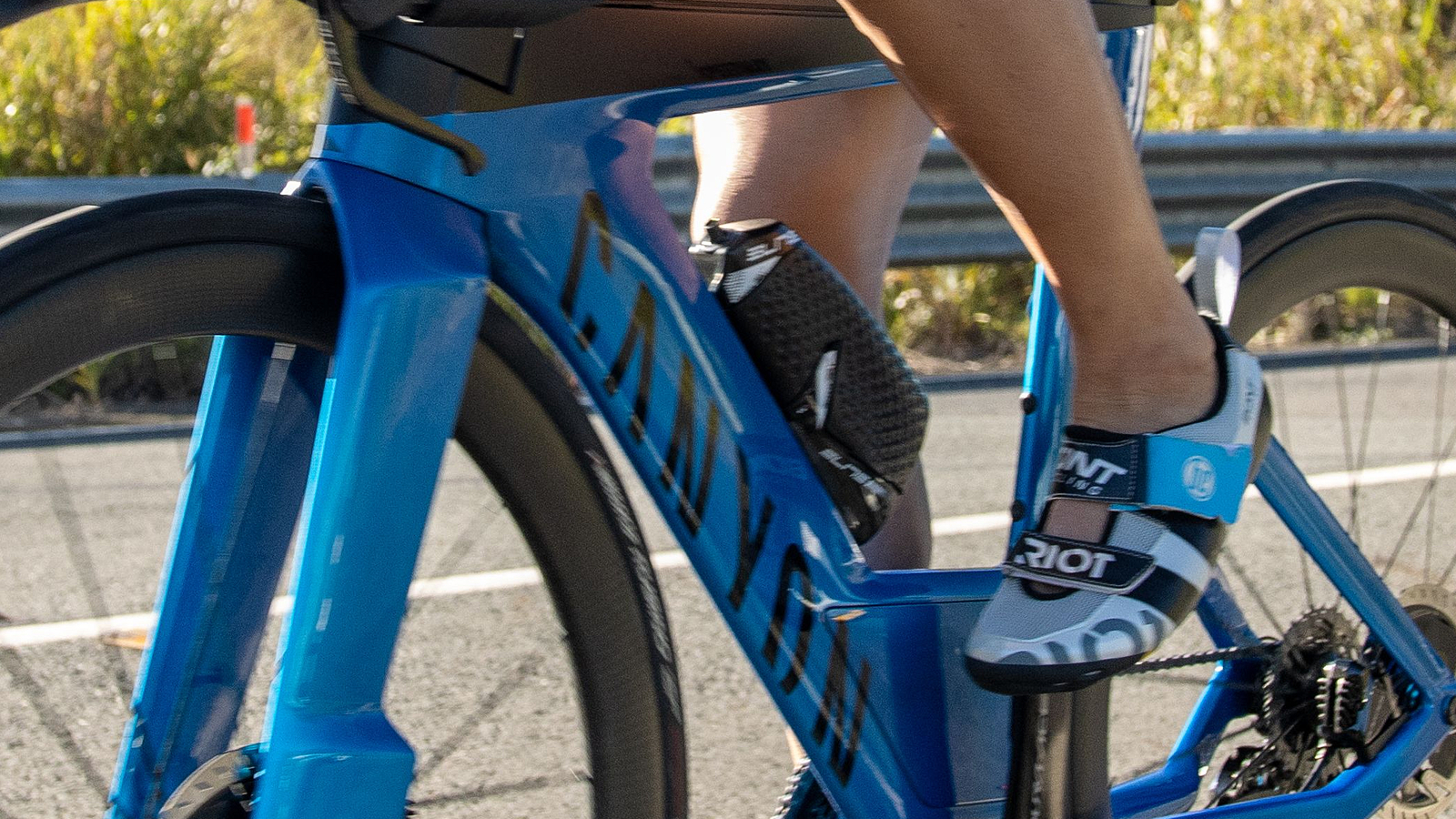
Transition is one of the most crucial moments in triathlon, and a key part of that is a quick change of shoes. Whether you are coming out of the water to climb onto the bike, or leaving the bike behind and getting ready for the run, you need a pair of shoes that is easy to slip on so that you can get going quickly. On top of that, you’ll want your shoes to be breathable, lightweight, and comfortable, especially for long-distance triathletes. Especially in Ironman competition, your feet already being sore is the last thing you want before starting a marathon.
Triathlon specific shoes are a game-changer for your racing, and if you’re a beginner looking to make the switch you’ll be glad to have a pair. You can shave a lot of time off your overall not just thanks to a faster transition, but improved aerodynamics and power transfer through the bike leg.
Triathlon-specific shoes are stiff, lightweight, comfortable, and quick in transition. They're also usually more heavily vented and quicker to dry than the best cycling shoes; you're coming straight out of the water after all! Noteworthy however, is the fact that they will also be suited to duathlon, which sees a run replace the swim leg to make for a run-bike-run event.
In this article, we’re going to detail our picks of the best triathlon shoes, all the while helping you to decide which pair will be best for you.
Best triathlon shoes available today
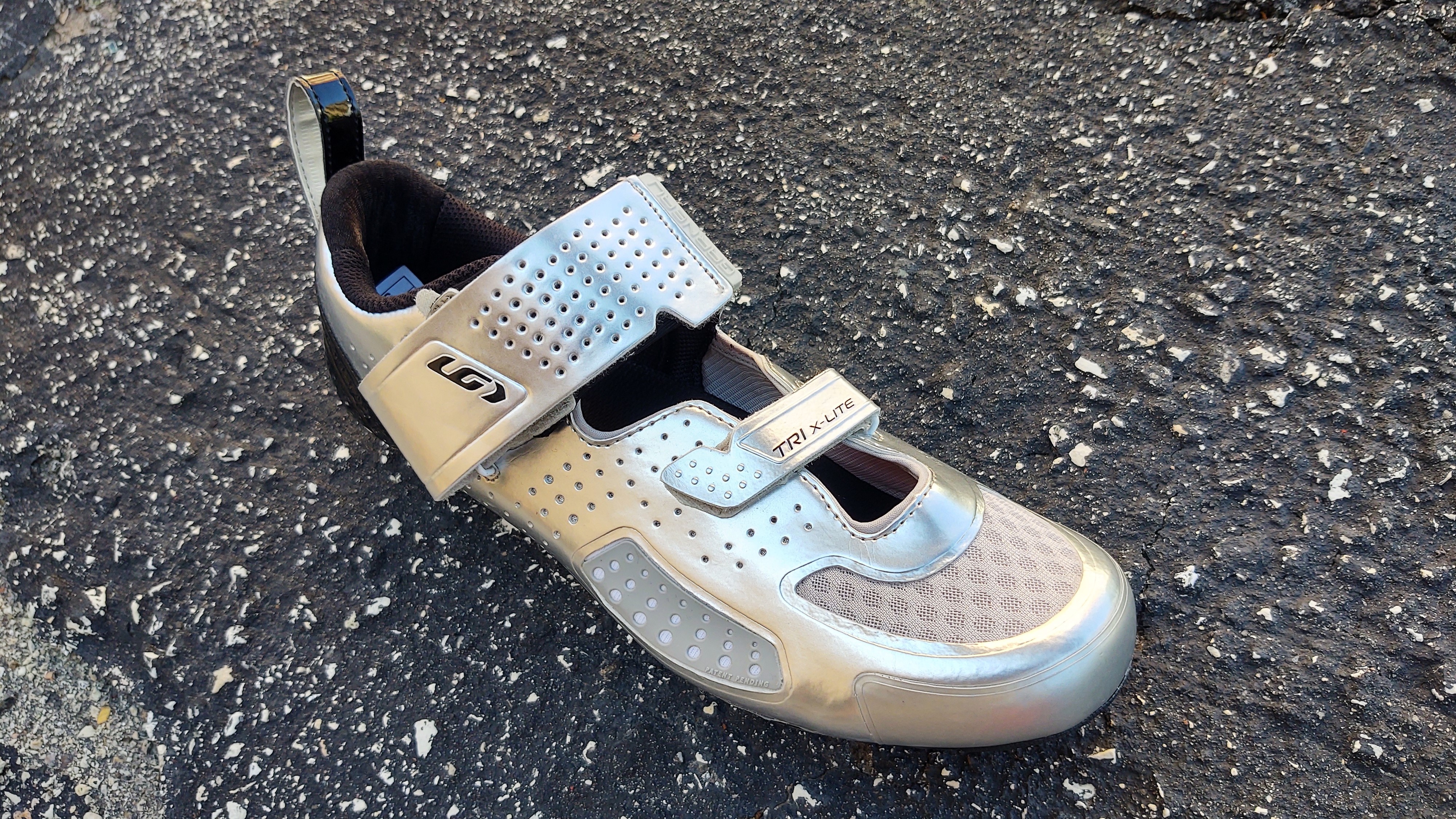
Louis Garneau X-Lite III
Specifications
Reasons to buy
Reasons to avoid
Louis Garneau is often underrated in the triathlon world, but it truly offers some great gear. The X-Lite III shoe is a significant upgrade from previous iterations, with a new fit and new technology that makes it faster than ever. However, the X-Lite III looks quite different from a traditional shoe as it has an open front.
The open front increases ventilation and improved drying time, but is can also be uncomfortable for some riders. The uppers are made from PU leather and mesh, and while they're quite light thanks to the absence of a tongue, there are lighter options out there.
Overall, the X-Lite III is not among the stiffest triathlon shoes, and so it is better for beginners than seasoned triathletes. These shoes are certainly comfortable (if you get on with the open front), but may not be the best for performance.
Where this shoe stands out is in transition, as the two hook and loop straps make it easy to slip in and slip out, as well as an oversized heel hook that is among the best available. The open front end is also great for hot weather and summer racing when staying cool is of the utmost importance. Additionally, Louis Garneau used its patented CoolMax insole made from a moisture-wicking material that helps your feet dry after the swim.
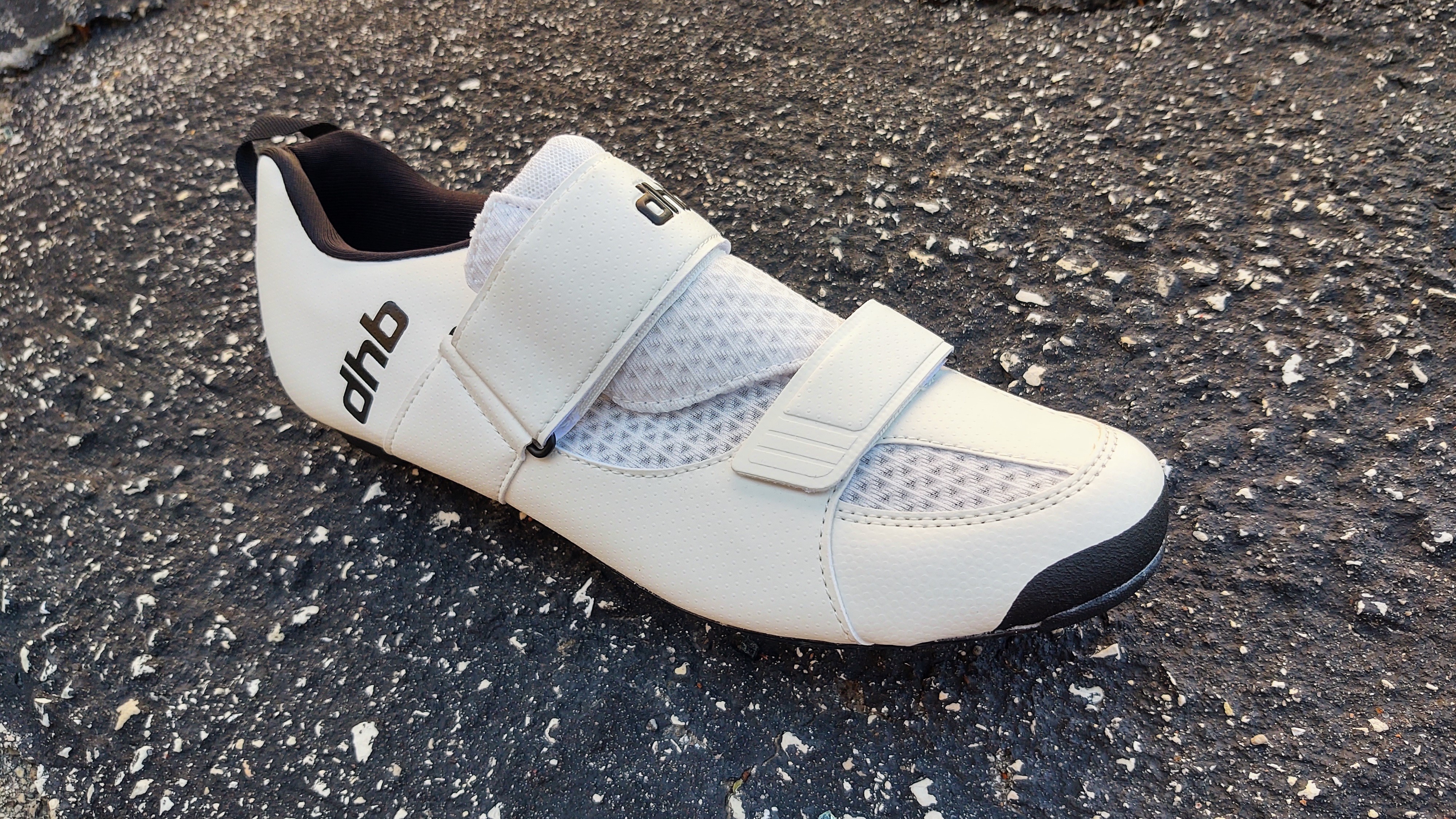
dhb Trinity
Specifications
Reasons to buy
Reasons to avoid
What you get here is the best value out of any triathlon shoe. While the pure performance may not be the best, the price tag certainly is. You could buy these shoes for yourself and a pair for three friends for the price of some competitors. For beginners and first-time buyers, the dhb Trinity is a highly valuable option.
As you might expect, this shoe comes with a Nylon composite sole, which is workable, but not as stiff or light as a pure carbon fibre option. However, the material is somewhat balanced by the lightweight synthetic upper and quick-drying, breathable mesh materials used throughout the shoe. It is the heaviest shoe on this list, but this won’t affect your performance on flat or rolling courses, only very hilly ones.
Offset heel pull tabs help improve transition times, while the crank arm fastening loop is an interesting design. It is a wide upper strap that helps stabilise the foot and is quick in transition, but it is not the most efficient or comfortable. A small Velcro strap over the toe box helps tighten the bottom portion of the shoe.
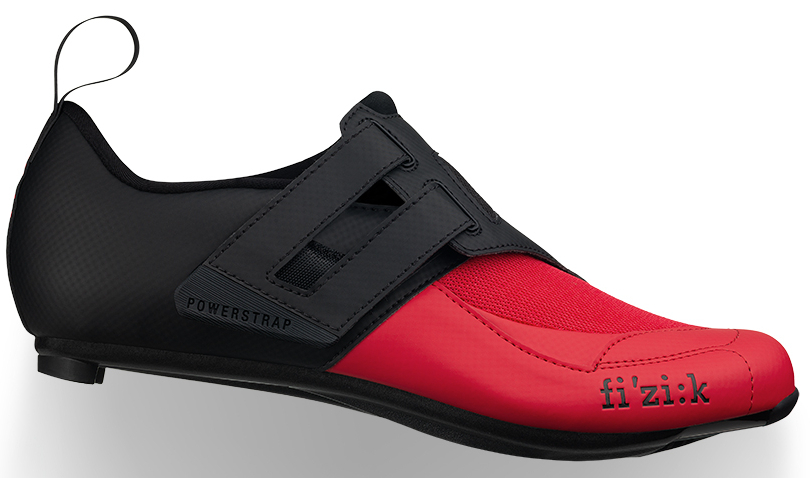
Fizik Transiro Powerstrap R4
Specifications
Reasons to buy
Reasons to avoid
The Powerstrap R4 is one of the most popular triathlon shoes, and for good reason; it's less than half the price of some competitors, making it a great shoe for triathlon beginners who don't want to invest too much to start with.
Not everyone will love the Velcro Powerstrap closure, which is the defining feature of this shoe. The closure is quick and easy, but it is less secure compared to other systems such as the Boa, and less efficient on the bike too. As such this shoe isn’t designed for elite triathletes, but it is perfect for beginners and those looking for a budget option.
That said, the Powerstrap R4 is a great shoe for short-distance triathletes when every second counts. This shoe is another that's fast in transition thanks to the Velcro Powerstrap, and is surprisingly easy to adjust during your ride.
The carbon outsole is quite stiff without sacrificing comfort, which helps improves overall power transfer. Mesh and Microtex materials provide plenty of ventilation and will help dry out the shoe after your swim.
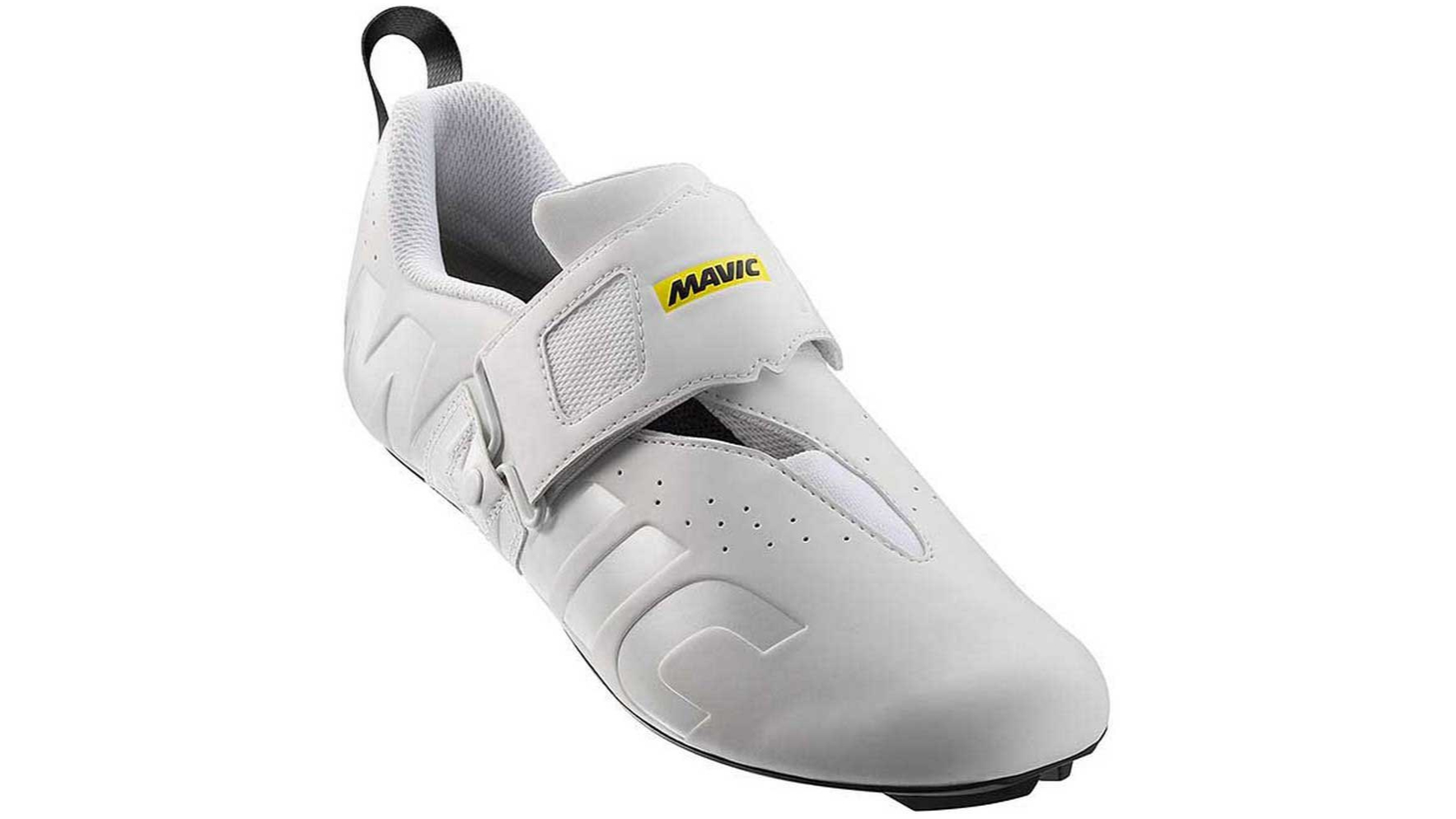
Mavic Cosmic Elite Tri
Specifications
Reasons to buy
Reasons to avoid
The Mavic Cosmic Elite Tri is one of the very best all-rounders thanks to its price point and included technologies. Using a wide strap and stiff sole, this shoe is great for short-course triathletes and experienced riders. It's not the most comfortable shoe on our list thanks to a very stiff sole, so perhaps is better suited to shorter courses.
An oversized heel hook is great for pulling on the shoe as quickly as possible, and the wide strap offer the same transition-shortening benefits. This strap can also be adjusted mid-ride, which helps balance out the stiff sole. The ventilation isn't brilliant, so again perhaps a shoe better suited to shorter courses.
The OrthoLite insole is one of the standout features of this shoe, offering cushioning and comfort alongside the micro-fibre upper which can adapt to the unique shape of your foot. The Energy Comp Outsole maximizes efficiency by bringing the rider’s sole closer to the pedal, but it is not fully carbon as you get with the (more expensive) Mavic Cosmic Ultimate Tri.
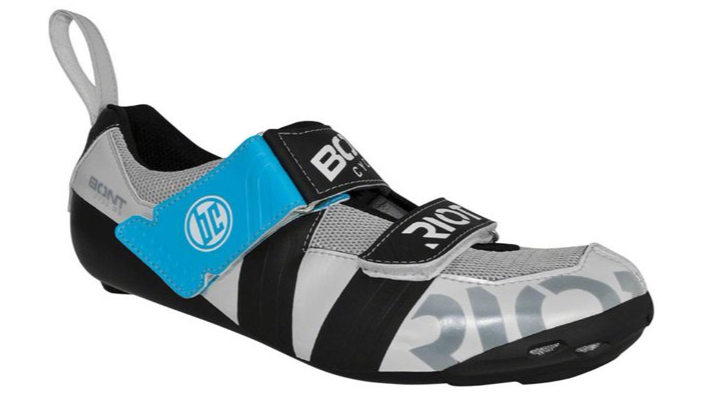
Bont Riot TR+
Specifications
Reasons to buy
Reasons to avoid
The Bont TR+ shoes is one of the most technical offerings in triathlon, designed to give you the very best in custom-fit technology, and to do it at a very reasonable price point. Bont designed the 'bathtub' footbed based on more than 20,000 foot scans to improve the efficiency of the TR+ triathlon shoe. Plus, you can take the fit to the next level by popping them in the oven and then moulding them to your feet while the epoxy resin in the soles is still pliable.
There may not be a more comfortable triathlon shoe than this, and not just because of the customisable fit. The inner sole also increases comfort too, while frontal air vents improve breathability.
The double Velcro straps won’t be for everyone, but they are certainly quick in transition and easy to adjust. It’s a bit of a conundrum since the rest of the Riot TR+ seems designed for long-course triathlon, whereas the strap system is better for short-course triathlon. Besides that, there isn’t much to complain about, especially since these shoes are some of the lightest on this list, and they also come in at just $160 / £144.99.
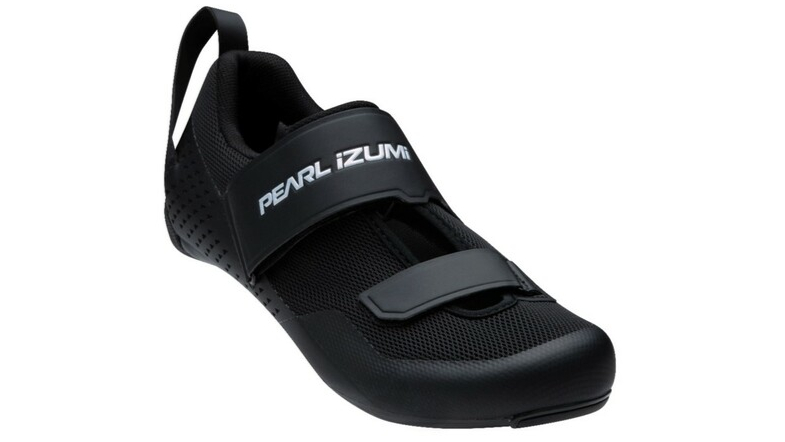
Pearl Izumi Fly 7
Specifications
Reasons to buy
Reasons to avoid
This shoe is perfect for beginner triathletes or those who have never bought a triathlon shoe before. It is not the lightest, fastest, or stiffest triathlon shoe – but it is one of the cheapest, easiest, and most comfortable.
A reinforced Nylon sole is not as stiff as other more expensive triathlon shoes, so you will be losing a bit of power transfer through the pedals, but what you lose in stiffness you make up for in comfort. This shoe also has double heel loops which help make for a quick transition, and the sole actually improves walkability, especially in the transition area.
The upper part of the shoe is mesh, which makes for decent breathability and quick-drying, although the quality is noticeably reduced compared to shoes which cost three or four times as much. Direct-Vent technology from Peal iZumi helps your foot stay cool and dry, while EVA foam and a rubber heel number increases stability. A notched main strap is fairly easy to use and quick in transition, although it is not the stiffest or most efficient fit for longer courses.
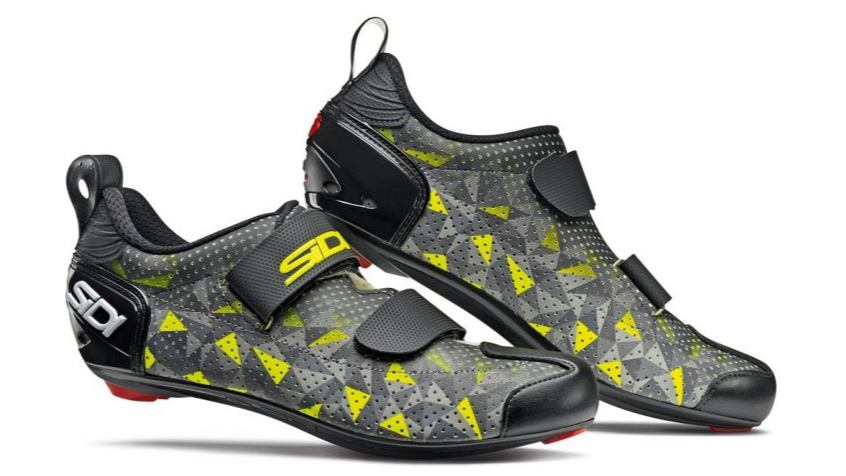
Sidi T-5 Air Carbon
Specifications
Reasons to buy
Reasons to avoid
Despite being designed for road cycling, the Sidi T-5 Air are incredibly comfortable – among the best-fitting of all the shoes on this list – even without socks. Yes they're technically road cycling shoes, but if you do both then these are worth a look.
These shoes have a perforated outer design which helps increase ventilation, bringing it up to the standard of most triathlon shoes. Each strap is comfortable and well-designed, improves comfort and decreases the risk of hot spots.
In the T-5 Air shoes, there is plenty of carbon, with an outsole made of a mix of carbon and nylon. The upper part of this shoe is made from Politex, which is a proprietary material that increases strength and durability – compared to the rest of this list, the Sidi T-5 Air shoes are arguably the most durable.
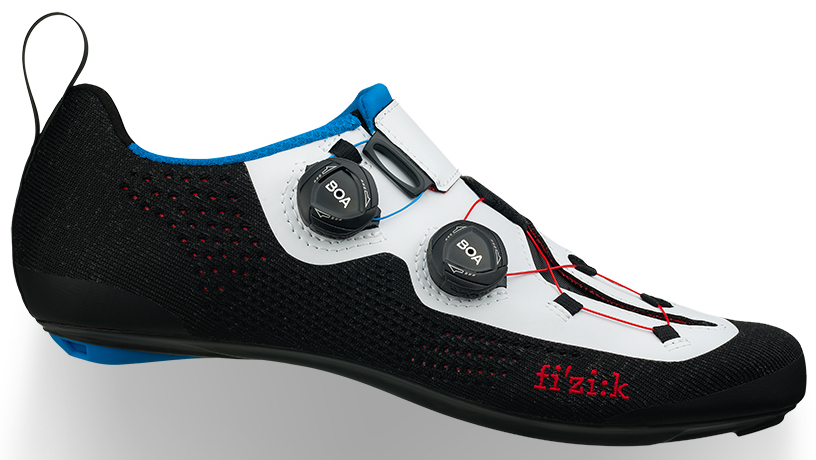
Fizik Transiro Infinito R1 Knit
Specifications
Reasons to buy
Reasons to avoid
Fizik’s high-performance triathlon shoe is made with their best materials and top-end technology. The price reflects the quality, but so does the weight. While the gram increase won’t affect your flatland performance, you can certainly feel the difference compared to Fizik’s other offerings.
The knitted upper is the standout feature of this shoe, providing the very best in breathability, and also great comfort. In fact, this shoe was specifically engineered to be as comfortable as possible without socks, fast in transition, and efficient on the pedals. The top portion of the shoe is made of performance yarn and there is even a water-repellent treatment used on the yarn, helping the R1 Knit shoes dry as quickly as possible.
Two Boa dials are used to provide the best fit and power transfer, which can also be used to fine-tune the shoe’s fit. There is also a Volume Control system which can be used to adjust the fit of the instep and forefoot.
New to this shoe is Dynamic Arch Support which wraps around the plantar arch, and can adjusted with its own Boa dial. This shoe is one of the very best in terms of overall comfort and breathability. It won’t be the fastest in transition, and it is certainly not cheap, but for elite and long-course triathletes, the Infinito R1 Knit could be the best fit.
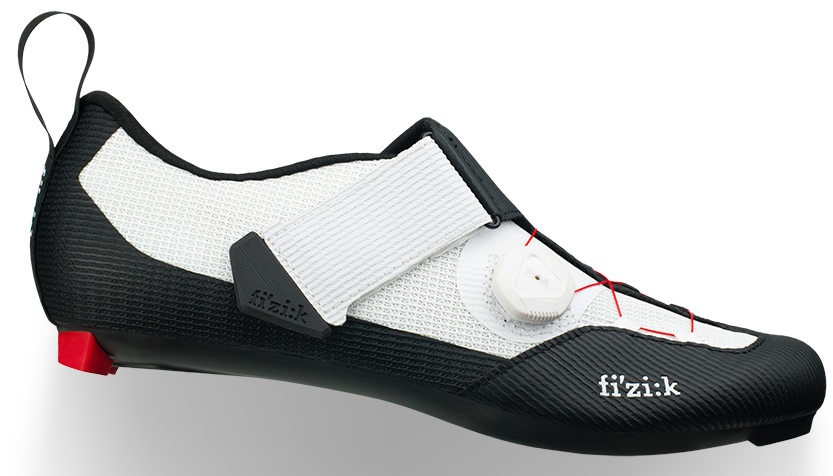
Fizik Transiro Infinito R3
Specifications
Reasons to buy
Reasons to avoid
In between the R1 Knit and Powerstrap R4, Fizik offers the Infinito R3 which combines the use of an Instep Powerstrap as well as a Boa closure. The Instep Powerstrap is slightly different from the Velcro Powerstrap, as it is designed for quicker foot entry and exit. We found this design to be marginally better than the Velcro Powerstrap – it’s something you’ll notice when trying on the shoes for the first time, but not when you’re in the heat of the moment in T2.
Materials are upgraded from the Powerstrap R4, as the Infinito R3 comes with PU laminated mesh upper that increases ventilation and offers support where needed, according to Fizik. In our experience we found the ventilation and comfort to be much better than the R4 on longer rides.
With a full UD carbon outsole, the Infinito R3 is incredibly stiff, providing great power transfer, even if the shoe does take some getting used to.
You may wonder what the “Infinito” name refers to – the Boa closure actually helps adjust the volume of the forefoot area on this shoe, and this adjustment system is called the Infinito. You can adjust the pressure and width of your shoe on the fly, which is an impressive feature, although it’s hard to say how much you will use it in practice. Triathletes with sensitive feet have a great option here, as well as long-distance triathletes looking for a comfortable and breathable shoe with plenty of adjustability.
How to choose the best triathlon shoes for you
What are your triathlon goals?
The best triathlon shoe for you is going to be the best all-rounder that fits your foot and your goals. For short-distance triathletes, a shoe that is quicker in transition is better than a shoe that is more comfortable. Whereas for an Ironman athlete who is on the bike for 6-7 hours, comfort is king and 30 seconds saved in transition could easily be lost if you need to stop to adjust your shoe.
Therefore, to find the best triathlon shoes for you, you must analyse what they'll need to provide.
What is your budget?
Cost and value is another balancing act, as it really depends on your triathlon goals and budget. For beginner triathletes, an affordable pair of shoes like the Pearl iZumi Fly 7 is a great choice, but for serious triathletes and aspiring pros, or simply those with bigger budgets, a premium shoe like the Fizik Transiro Infinito R1 Knit could be well worth the cost if it improves your speed and comfort, helping shave minutes off of your PR.
As with any purchase, make a mental note of your budget and see whether you can get all the features you need within that price. If not, you'll need to make some concessions on spec.
Try before you tri
Perhaps the most difficult part of shoe-buying is sizing and fit. Every shoe is different, and thus it will feel different around your foot. Smaller and tighter shoes work best for some triathletes, while others prefer wide and breathable shoes. If possible, try on the shoes before buying them.
What makes a good triathlon shoe?
The way we see ity, triathlon shoes have three jobs. The first is a need to be quick and easy to put on. Or, perhaps more pertinently, easy to put on whilst riding once you're up to speed. Most triathletes will leave their shoes clipped into their bike, so that when they leave the water and they've changed from their wetsuit and put their helmet on, there's no faffing putting on the shoes. Then, after a few minutes of pedalling with your feet resting on top of the shoes, they can be put on 'properly' while you're moving.
To achieve this, they need to be able to open up quite loose, to make them easy to slip into. They then need to be easy to tighten on the move - which rules out laces (Elastic speedlaces aside).
Their second job is the same job as any other cycling shoe: On-bike performance, including stiffness, comfort and aerodynamics. This means they need to be well made and use well-chosen materials, and designed to fit properly.
Their third job is to be removed easily, because at the end of the bike leg, you'll be met with T2, before your run. The properties for this job are similar to the first, but with the added need to undo them quickly. A Boa dial or velcro strap is probably best in this regard.
Once you've found a shoe that can do all of those things, your additional spend will go towards lighter materials, increased power transfer and added features like elastic loops to keep them level during T1.
Get The Leadout Newsletter
The latest race content, interviews, features, reviews and expert buying guides, direct to your inbox!
Zach is a freelance writer, the head of ZNehr Coaching, and an elite-level rider in road, track, and e-racing. He writes about everything cycling-related, from buyer's guides to product reviews and feature articles to power analyses. After earning a Bachelor’s Degree in Exercise Science at Marian University-Indianapolis, Zach discovered a passion for writing that soon turned into a full-fledged career. In between articles, Zach spends his time working with endurance athletes of all abilities and ages at ZNehr Coaching. After entering the sport at age 17, Zach went on to have a wonderful road racing career that included winning the 2017 Collegiate National Time Trial Championships and a 9th place finish at the 2019 US Pro National Time Trial Championships. Nowadays, Zach spends most of his ride time indoors with NeXT eSport.